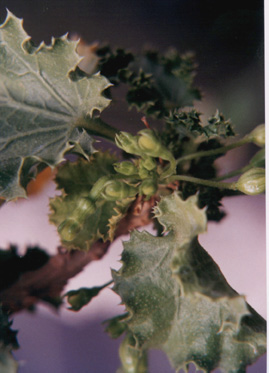
A cluster of flowers. A female (lower left) can be picked out by the inferior ovary (looks like a small zucchini just below the flower.)
|
|
Native to Socotra, a small island off the "horn" of Africa, Dendrosicyos socotrana is a truly unusual and in cultivation, an extremely rare plant. Individuals in habitat can attain 10 feet/3 m in height and with a trunk X diameter. I have always been seeking this plant since I first read of it in Carlquist's book "Island Life." Only two California botanical gardens that I know of had the plant, UC Davis Plant Sciences greenhouse and the Huntington Botanical Gardens in San Marino. Attempts at rooting cuttings from Davis always failed, so I realized that for CSUF to get a plant, I would have to get seed.
Tim Metcalf, the curator of the Plant Sciences greenhouses at UC Davis commented that their plant was a "male" as it only produced male flowers. However, the drawing in Carlquist's book clearly shows a female flower surrounded by male flowers. Davis' plant was quite large with a bottle-like trunk that was at least a meter in height. In 1990, the plant was repotted. That summer, both types of flowers were produced and Tim promptly pollinated the female and held his breath as it was not known if the plant was self sterile. He didn't have long to wait- within weeks, a fruit was growing and produced viable seed. CSUF got several seedlings the following spring.
I decided to give the plants maximum pot room, and they were transplanted into 5 gallon containers in a mix that was mostly pumice. The seedlings were placed in the cactus house, which is unshaded. Watering was at least twice weekly with inline fertilizing during the summer; less frequently to dry during the winter months. Absolute minimum temperatures were held to between 50-55 F/ 10-12 C during the winter months. Maximums ranged into the upper 90's/37 C during the summer.
With this treatment, the plants grew relatively fast, but didn't get taller than a meter. Trunks were succulent, but definitely not bottle-shaped. Perhaps this would come in time.
The first plant produced flowers at five years from seed. Both sexes were present, but with a preponderance of male flowers. Flowering occurred near the tips of the formerly upright growing main shoot. The leaves, which are extremely prickly in vegetative growth became larger and less prickly. A more "user friendly" leaf that would not interfere with attempts to pollinate. Only one of the two plants initially flowered, but Tim's initial success with seed production gave us a clue that this would not be a problem.
Seeds were planted in the summer in pumice about .5 inch/ mm deep. Watering was regular and generous. Germination occurred witin two weeks at over 90%, probably due to the freshness of the seed. It seems no afteripening is necessary as is the case in some desert plants. Seeds were not scarified.
We are currently trying one outside in full sun. It went through our El Niño rains without any ill effects. A low temperature of 30F/-1C was tolarated. We'll see when we get more cold weather. I suspect that if the weather is very cold and wet, the plant will suffer, so we'll probably keep it under cover, but where it can get full sun, to keep it dry during our normally wet winters.

|
A cluster of flowers. A female (lower left) can be picked out by the inferior ovary (looks like a small zucchini just below the flower.) |
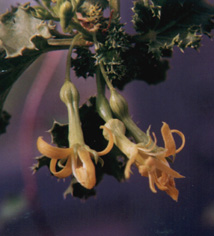
|
Another cluster of flowers; the female is the center one. Pollination was done as early in the day as possible with freshly opened flowers, especially female. Male flowers a day old still had viable pollen. |
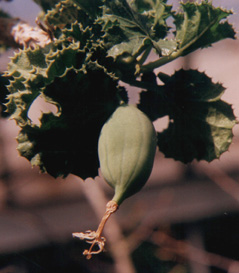
|
A developing pickle! The male flowers have long since fallen off. |
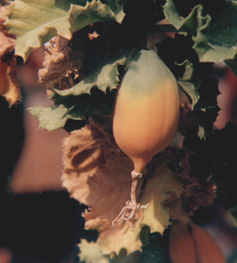
|
A partially ripened fruit. |
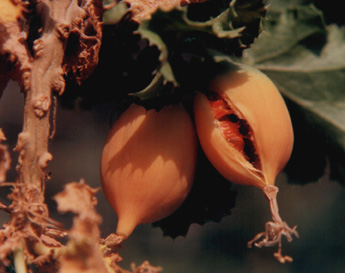
|
More ripening fruit. Note that one has begun to split. |
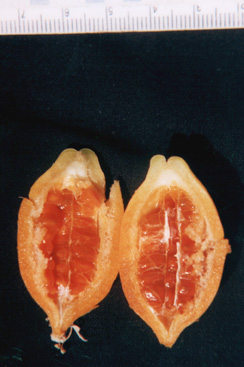
|
Logitudinally sectioned fruit.The bad odor previously reported was not evident at this time. |
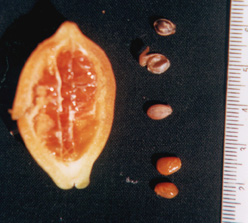
|
A section of the fruit with seeds on the right. The bottom two seeds are fresh from the fruit, surrounded with a bit of orange flesh. In the middle, a seed has been cleaned of flesh, but the translucent covering remains. The top pair includes a naked seed with its translucent cover below. A very fine velvet layer covers the flat sides of the seed. The seeds are about 6 mm long. |
|
|
|